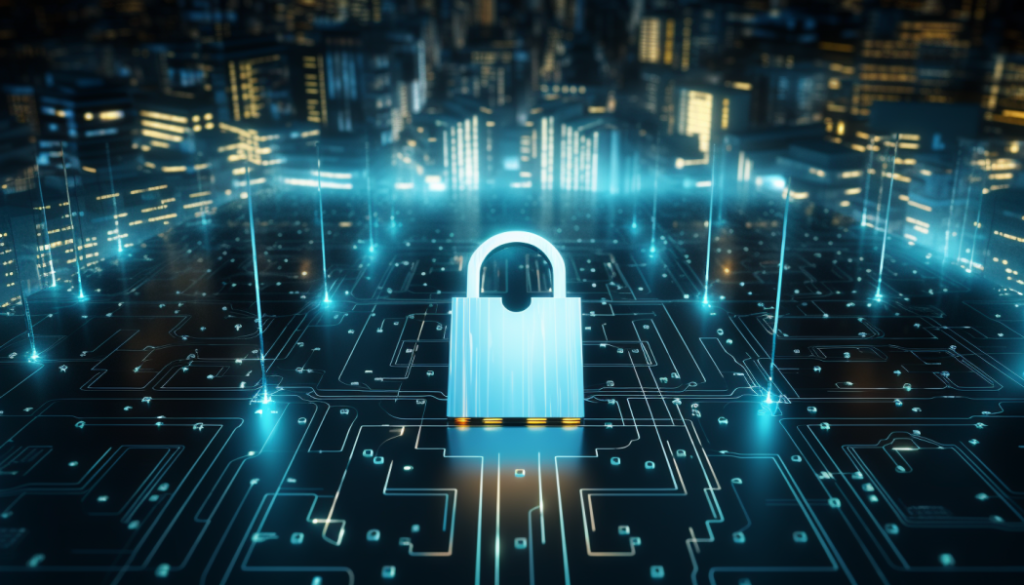CRAFTING YOUR CYBER SECURITY STRATEGY: A COMPREHENSIVE GUIDE

With digital transformation rapidly evolving, cybersecurity has become a critical concern for both businesses and individuals. Establishing a robust cybersecurity strategy is no longer a luxury, but an absolute necessity.
The Importance of Cyber security Strategy
Cybersecurity strategies are pivotal to ensuring the safety of your digital assets. Without a solid strategy, your system becomes susceptible to a myriad of cyber threats including data breaches, ransomware, phishing incidents, and more.
A cybersecurity strategy is an organization’s blueprint for dealing with potential cybercrime, including:
- Identifying key assets and the possible threats they face.
- Developing an effective response to potential security breaches.
- Training staff in security best practices.
- Regular audits and updates to ensure continuous protection.
Understanding the Current Cybersecurity Landscape
Today’s cybersecurity landscape is an ever-changing one, with new security threats emerging at an unprecedented pace.
You can’t effectively protect yourself if you’re not up-to-date with the latest cyber challenges.
Thus, the first step in crafting a successful cybersecurity strategy is to understand the current landscape of cyber threats.
Stay informed about the evolving threat landscape and keep an eye on the latest cybersecurity news and trends.
In the end, understanding the importance and the current scenario of cybersecurity helps in forming an effective cybersecurity strategy.
Stay safe in this digitally advanced yet perilous era.

Assessing Your Cybersecurity Needs
The first step to set up a robust cybersecurity strategy is to assess your organization’s needs correctly, and it starts by identifying potential threats and evaluating vulnerabilities.
Identifying potential threats
There can be numerous potential threats in the digital world, from phishing scams and ransomware to DDoS attacks and internal threats.
To properly address these issues, you need to:
• Identify any specific threats your organization might be especially susceptible to. Consider factors such as industry, size, location, and specifics about your digital systems.
• Stay informed about the latest cyber threats. Technology is continually changing, and new threats can emerge any time.
Evaluating your organization’s vulnerabilities
It is equally important to understand where your organization is most vulnerable. This will involve:
• Conducting a risk assessment. This will help you to evaluate which systems are most critical and therefore need the most protection.
• Considering possible human error. This includes weak passwords, forgetting to log out, or even clicking on dangerous links. Employee training may help strengthen these weak points.
Only with an accurate assessment can you effectively prioritize your cybersecurity needs and develop a tailored strategy. Understanding both your potential threats and your organization’s vulnerabilities is crucial.
This understanding forms the basis for a solid cybersecurity strategy.
Establishing Security Policies and Procedures
Moving forward with building your cybersecurity strategy, you need to establish robust information security policies and procedures.
These policies serve as guidelines that shape your organization’s approach to security and stack the first line of defense against potential cyber threats.
Creating a strong password policy
Implementing a strong password policy is crucial. Forcing employees to use complex passwords—made up of letters, numbers, and symbols—can offer an additional layer of protection. It’s recommended to change passwords every 60-90 days. Moreover, avoid using the same password throughout multiple systems and applications to minimize the risks.
Implementing two-factor authentication
Two-factor authentication (2FA) is another potent tool to enhance your organizational security. Not just relying on a password, 2FA adds another verification layer, such as a confirmation text message, email, or app notification. Implementing 2FA where possible can help to strengthen security norms and protect against unauthorized access.
Remember, a robust cybersecurity strategy isn’t solely about the technological defenses; it’s equally about the correct policies and practices. Investigate what you have and identify areas for improvements.
Undoubtedly, these two steps will pave the way to a secure cyber environment within your organization.

Choosing the Right Security Tools
When setting up a robust cybersecurity strategy, using the right security tools is vital. Ensuring your system has the best protective elements can make a whole world of difference in mitigating cyber threats.
Antivirus Software
Antivirus software is crucial for every device. It acts as the first line of defense by scanning, detecting, and eliminating threats before they unleash damage.
They can protect against various threats, like viruses, trojans, ransomware, and other forms of malware. Some of the best antivirus software on the market includes Norton, Bitdefender, and McAfee.
Firewalls and Intrusion Detection Systems
Firewalls serve as a security guard, monitoring and controlling incoming and outgoing network traffic based on predetermined security rules.
They establish a barrier between secured internal networks and untrusted external networks, such as the internet.
Intrusion Detection Systems (IDS) are designed to monitor network traffic for suspicious activity and known threats, sending alerts when such activities are discovered.
- Antivirus software scans and eliminates threats before they can cause damage.
- Firewalls control network traffic, preventing unauthorized access.
- Intrusion Detection Systems alert when suspicious activities are detected.
Therefore, combining these tools will give you a more comprehensive security approach, protecting you from various angles.
Employee Training and Awareness
Education of employees forms the most significant line of defense in any cybersecurity strategy. Every employee should be aware of their responsibility to protect company’s data from potential threats.
Educating employees about phishing and social engineering attacks
Phishing and social engineering attacks are among the most common cybersecurity threats faced by businesses today. As such, it’s crucial to educate your employees about these types of attacks to prevent potential data breaches.
- Teach your employees about the signs of phishing emails, such as requests for personal information, poor grammar and punctuation, and suspicious email addresses.
- Explain the dangers of social engineering attacks, where a third party manipulates individuals into breaching security protocols or revealing confidential information.
- Encourage employees always to verify suspicious requests, either by checking with a manager or using the IT department’s resources.
- Incorporate cybersecurity education into onboarding for new employees and have regular training sessions to keep all team members updated on new threats.
In essence, a well-informed employee can act as an effective human firewall, significantly reducing the company’s vulnerability to phishing and social engineering attacks.
These steps can form an integral part of an effective cybersecurity strategy.

Incident Response Planning
Establishing an Incident Response (IR) plan is a pivotal step in curating a holistic cybersecurity strategy. Identifying potential threats and having set procedures to deal with them ensures minimal damage and quick recovery times.
Developing a framework for responding to security incidents
Creating a response framework involves laying out the steps to be followed when a security breach occurs. This protocol generally includes:
- Identifying the type and scale of the breach
- Containment and eradication of the threat
- Recovery of affected systems and data
- Post-incident analysis to prevent future occurrences
Creating an effective communication plan
An efficient communication strategy is necessary to manage the information flow during and after a security incident. Such a plan should specify:
- Who needs to be contacted (internal teams, third party solution providers, law enforcement, clients, etc.)
- When to initiate communication
- The mode of communication
Having these protocols in place can help reduce chaos and ensure efficient resolution of cybersecurity incidents. Remember, it’s not just about having the tools to protect your organization.
It’s about knowing what to do when a security incident occurs. It’s always better to be prepared!
Regular Security Assessments and Audits
Staying one step ahead of potential security threats is crucial in maintaining an effective cybersecurity strategy.
This is where regular security assessments and audits come in.
Conducting periodic vulnerability assessments
Vulnerability assessments are integral to any successful cybersecurity strategy. These assessments involve identifying, quantifying, and prioritizing (or ranking) the vulnerabilities in a system.
Regularly conducting these checks helps organizations gain a clearer picture of their overall cybersecurity status and areas that need improvement. By doing so:
- You can monitor changes in network security.
- It enables the early detection of vulnerabilities.
- You can prioritize security measures.
Performing penetration testing
Penetration Testing, or pen testing, is the practice of testing a computer system, network, or application to find security vulnerabilities that an attacker could exploit.
Penetration testing can be automated with software applications or performed manually. The benefits of regular pen testing include:
- Identifying potential paths an attacker could use to exploit.
- Providing realistic assessments of potential attack impact.
- Offering evidence to support increased investments in security personnel and technology.
Remember, the primary purpose of both assessments and audits is not to find faults or point fingers but rather to illuminate cyber risks and areas for improvement and enhance overall system robustness.
Ensuring regular security assessments are conducted provides an ongoing health check of cyber defenses and acts as a crucial part of an effective cybersecurity strategy.

Embracing Encryption and Secure Communication
When setting up an effective cybersecurity strategy, it’s crucial to incorporate data encryption and secure communication. Using encryption can help protect sensitive data from being accessed by cybercriminals.
Securing sensitive data with encryption
Encrypting your data is an integral part of any cybersecurity strategy. It helps protect your data by turning it into unreadable code.
This way, only those with the correct encryption key can decipher it. With several options available, like Symmetric or Asymmetric encryption methods, it’s essential to choose one that best suits your business needs.
Using encrypted messaging and email services
In addition to encrypting data, secure communication is also vital to maintain data privacy. Encrypted messaging and email services add an extra layer of security, making it much tougher for intruders to intercept and read your communications.
Key strategies to consider:
- Choosing an encrypted messaging app like Signal, Wire or Telegram.
- Transitioning to encrypted email services such as ProtonMail or Tutanota.
In summary, incorporating encryption and secure communication into your cybersecurity strategy is critical in fighting against data breaches and other forms of cyber crimes.
Cloud Security Considerations
In 2023, as cloud computing continues to dominate the tech industry, it’s more important than ever to secure your data effectively when stored online.
Numerous factors are critical when considering cloud security.
This section looks at two of these: choosing a reputable cloud provider and implementing proper access controls and encryption.
Choosing a reputable cloud provider
With numerous cloud service providers in the market, it’s crucial to select one that prioritizes security.
Look for a provider like Amazon Web Services (AWS), Microsoft Azure, or Google Cloud Platform that have robust security measures in place and maintain a good track record in protecting customer data.
Don’t forget to inspect their data breach history and the steps they took in response.
Implementing proper access controls and encryption
While choosing a reputable provider is essential, so too is implementing proper access control and encryption.
- Access controls: Use strict permissions to only allow necessary personnel access to certain data. This minimizes the risk of data falling into the wrong hands.
- Encryption: Use powerful encryption for data both at rest and in transit to ensure the information remains unreadable even if it’s intercepted or accessed without authorization.
Getting these two aspects of your cloud security strategy right could mean the difference between a safe, working cloud environment and falling victim to a cyber breach.

Monitoring and Continuously Improving Security Measures
Cybersecurity is an ever-changing field that requires constant vigilance.
One way to ensure that your organization remains protected is by implementing effective security measures and then consistently monitoring and improving them.
Utilizing security monitoring tools
Security monitoring tools play an essential role in a holistic cybersecurity strategy. Some of these essential tools include Intrusion Detection Systems (IDS), firewalls, and Anti-Malware software.
These tools work together to monitor your system’s vulnerabilities and protect it against potential attacks. Specific measures include:
- Regular automated scans to detect malware, viruses or any signs of intrusion
- Cloud-Security solutions to protect data in transport and at rest
- Email filters to block potential phishing scams
Staying up-to-date with the latest security best practices
In the rapidly evolving landscape of cybersecurity, being complacent is not an option. Staying up-to-date with the latest security practices is a must. Some practices that organizations should adopt include:
- Continuous training and education for employees to be aware of the latest threats and scams
- Regular updates and patches of software and hardware
- Implementation of multi-factor authentication wherever possible
By continuously evolving your security measures, you’re on the road to establishing an effective cybersecurity strategy that keeps your work, data, and system protected.
Conclusion – How to Set Up an Effective Cyber security Strategy
To ensure an effective cybersecurity strategy, it is not enough to adopt an approach built on existing knowledge. The digital landscape is continually changing.
Hackers are constantly developing new attacks, and our network environments are steadily evolving.
Hence, an ongoing evaluation and continuous improvement of the cybersecurity strategy is essential for any organization.
Ongoing evaluation and improvement play a critical part in maintaining an impenetrable defense. They allow businesses to:
- Understand how changes in the industry impact their cybersecurity framework.
- Learn from past security incidents, transforming them into opportunities for improvement.
- Adapt their cybersecurity strategies according to recent threats and vulnerabilities.
The cybersecurity landscape is ever-evolving. Sadly, no plan is foolproof against all cyberattacks.
However, armed with the knowledge of past experiences, the focus should always be on refining the cybersecurity strategy. Remember, a flexible and dynamic approach is a significant step toward robust cybersecurity infrastructure.
Remember, cybersecurity maturity is not a one-time solution but a continuous process. Keep evaluating, learning, and improving.
That’s the only way to stay one step ahead in this cyber race.
Step into a secure future with Cyb-Uranus! We’re dedicated to equipping SMEs with state-of-the-art Cyber Security strategies, ensuring you’re shielded from cyber threats in the ever-evolving digital landscape. Cyber security is no longer an after-thought – it’s your success strategy. Contact us at Cyb-Uranus and take the first step towards securing your business in the Internet of Things (IoT) era today!

